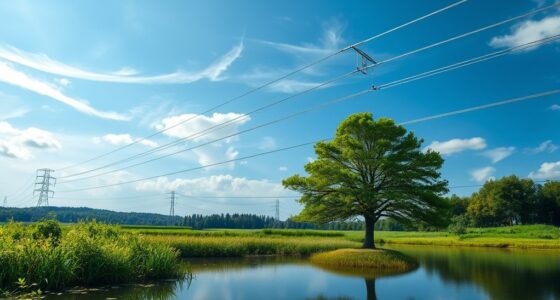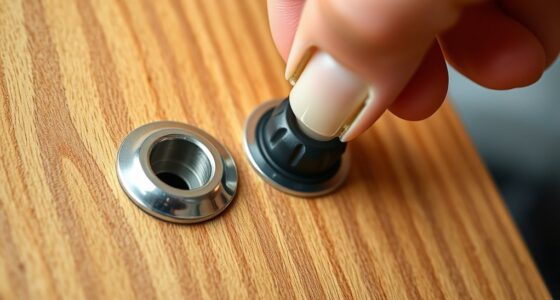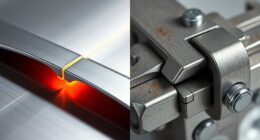Understanding the cable bending radius is vital because it prevents damage and guarantees reliable performance. Bending a cable too tightly can stress internal conductors and insulation, leading to early failure or signal issues. Proper radius helps maintain flexibility, durability, and signal integrity over time. Different cables have specific standards, so following guidelines is essential for safety and longevity. Keep exploring; you’ll learn how to choose the right bend radius and install cables safely.
Key Takeaways
- Proper bending radius prevents internal damage and maintains cable performance.
- Exceeding recommended radius causes conductor stress, insulation damage, and reduces lifespan.
- Material flexibility and installation environment influence safe bending limits.
- Following manufacturer guidelines ensures signal integrity and system reliability.
- Proper cable management minimizes interference and prolongs cable durability.
Understanding the Concept of Bending Radius
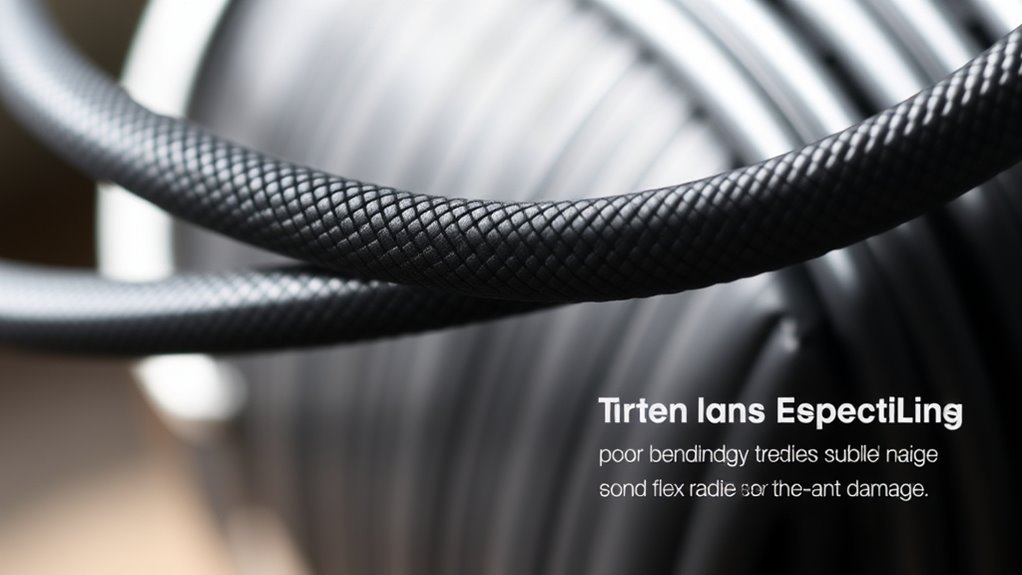
Understanding the concept of bending radius is essential because it determines how tightly a cable can be bent without causing damage or performance issues. The bending radius is the minimum curve you can bend the cable without compromising its integrity. Cable insulation plays a key role here, as it affects the cable’s bending flexibility. High-quality insulation materials allow for more flexible cables that can bend more sharply without cracking or breaking. Conversely, stiff insulation limits bending flexibility, requiring a larger radius to prevent damage. Knowing the correct bending radius helps you avoid overstressing the cable, which can lead to failure or reduced lifespan. Additionally, selecting the appropriate insulation material can significantly enhance a cable’s ability to withstand bending stresses. Proper installation techniques and understanding cable specifications are also crucial in maintaining cable performance. The mechanical properties of the cable influence how well it can handle repeated bending and stress, which is vital for long-term durability. Moreover, understanding security zone info can help in planning cable routes that minimize risk and ensure safety in complex installations. By understanding this concept, you can ensure your cables stay functional and safe, even in tight or complex installations.
The Impact of Bending Radius on Cable Durability

When a cable is bent beyond its recommended radius, its durability can suffer considerably. Excessive bending causes stress on the cable material, leading to potential damage over time. This stress weakens the internal conductors and insulation, increasing the risk of failures. Your installation environment also plays an essential role; harsh conditions can accelerate wear and tear. To prevent this, consider these factors:
Exceeding recommended bending radii damages cables, causing internal stress and accelerated wear over time.
- Cable Material: Rigid materials may be more prone to cracking under tight bends, reducing lifespan.
- Bending Radius Compliance: Staying within manufacturer-recommended radii ensures longevity and reliable performance.
- Environmental Conditions: Moisture, temperature fluctuations, and mechanical stress in your environment can magnify bending impacts, hastening deterioration.
- Proper Installation Techniques: Using correct bending methods and tools helps maintain the integrity of the cable and preserves its bending radius. Proper attention to cable flexibility also plays a crucial role in preventing damage.
- Additionally, understanding the vetted quality standards of cables can help in selecting products that are more resistant to mechanical stress and bending-related damage.
Proper attention to bending radius preserves cable durability and guarantees peak operation.
Factors Influencing the Proper Bending Radius
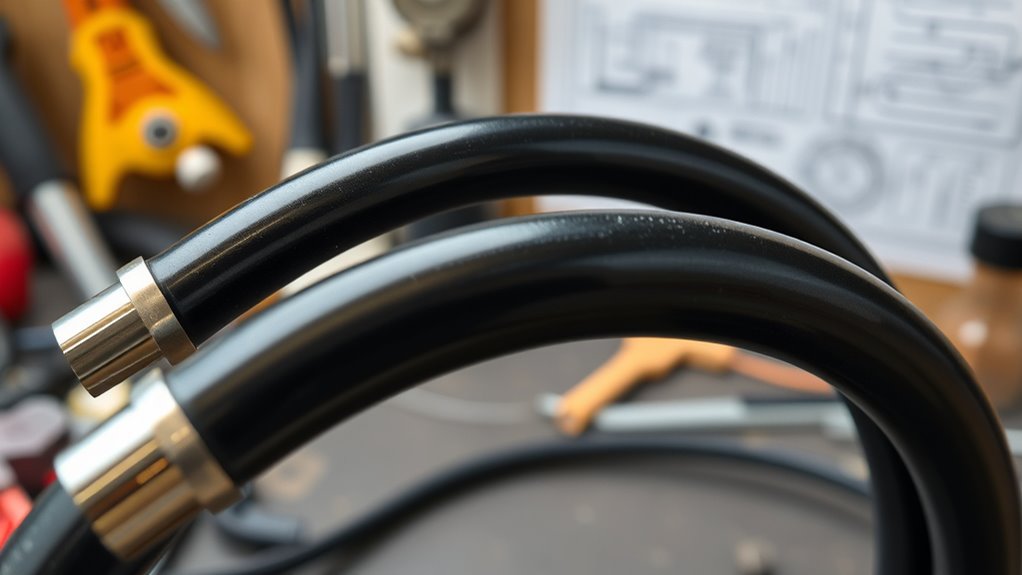
Several key factors determine the proper bending radius for your cables, ensuring they maintain ideal performance and longevity. Material flexibility plays a vital role; more flexible cables can be bent tighter without damage, while stiffer cables require a larger radius. Your installation environment also influences the bending radius—harsh conditions like extreme temperatures or exposure to chemicals may necessitate a gentler bend to prevent stress and deterioration. Additionally, cable type and construction impact the minimum bend; for instance, fiber optics need careful handling, whereas power cables might tolerate tighter bends. Considering these factors helps you avoid damaging your cables during installation or use, preserving their lifespan and ensuring reliable operation. Proper cable management techniques also contribute significantly to maintaining cable integrity over time. Tailoring your approach based on material flexibility and environment is essential for maximum results. Being aware of cable specifications can further assist in selecting the appropriate bending radius for different applications.
How to Measure and Determine the Correct Bending Radius

To guarantee you choose the right bending radius, you need to measure accurately using proper techniques. Focus on selecting a radius that matches the cable’s specifications and application needs. By understanding how to measure and determine the correct radius, you can prevent damage and maintain cable performance. Incorporating industry trends into your process can further optimize your selection. Additionally, considering the latest AI discoveries can provide innovative insights for future cable management solutions. Staying informed about best practices in cable installation ensures longevity and safety. Proper planning and adherence to size restrictions are also essential to ensure compliance and optimal performance.
Proper Measurement Techniques
Measuring the correct bending radius is essential to guarantee the cable’s integrity and performance. To do this accurately, you should:
- Use a flexible ruler or a bending gauge designed for fiber optic cables to trace the bend. This helps assess the cable’s flexibility and assure you don’t exceed manufacturer recommendations.
- Mark the minimum bend radius directly on the cable, avoiding sharp turns that could damage internal fibers.
- Always measure along the curve’s outer edge, not the center, for an accurate radius reading. Proper measurement techniques prevent strain, maintaining cable longevity and signal quality.
- Refer to Glycolic Acid Benefits for Skin to understand how proper exfoliation and care can prolong the efficacy of your cables by reducing buildup and stress. Additionally, understanding cable specifications can help ensure you stay within safe bending limits and avoid damaging the internal conductors. Incorporating best installation practices can further enhance the durability and performance of your cables over time.
- Proper installation practices are crucial to maintaining the cable’s performance and avoiding accidental damage during setup.
Selecting Appropriate Radius
Choosing the right bending radius is crucial to prevent damage and guarantee ideal cable performance. To do this, consider the cable’s flexibility—softer, more flexible cables can usually bend tighter without harm. Check the manufacturer’s specifications, which often include recommended minimum bend radii. When measuring, verify the bend radius is not too small, as excessive bending stress can cause internal damage or breakage over time. Use a flexible ruler or a specialized measuring tool to accurately determine the radius. Remember, the goal is to balance the need for tight bends with the cable’s capacity to handle bending stress safely. Proper selection of the radius minimizes strain, preserves cable integrity, and ensures longevity and reliable performance in your installation. Incorporating knowledge about sound vibrations and their effects can also aid in understanding how mechanical stress impacts cable materials over extended use. Additionally, understanding cable insulation properties helps in selecting the appropriate bending radius to avoid compromising the cable’s protective layers. Recognizing minimum bend radius standards established for different cable types is essential to ensure compliance and avoid damage during installation. It is also beneficial to consider the flexibility rating provided by manufacturers, which indicates the cable’s capacity to withstand bending without degradation.
Common Mistakes and Risks of Ignoring Bending Radius Guidelines

Ignoring bending radius guidelines can cause serious cable damage, leading to costly repairs or replacements. It also increases the risk of signal interference, which can disrupt your system’s performance. Understanding these risks helps you avoid common mistakes and guarantees reliable, long-lasting cable installations. Properly managing cable bend radius is essential to prevent damage and ensure optimal system functionality.
Cable Damage Risks
Ignoring proper bending radius guidelines can substantially damage cables, leading to premature wear and failures. When you disregard these guidelines, you increase bend stress, which strains the cable’s internal components and reduces cable flexibility. This damage can compromise insulation, cause conductor breakage, and lead to signal loss or complete failure. To prevent these issues, consider these risks:
- Reduced lifespan due to material fatigue from excessive bend stress.
- Increased likelihood of internal conductor damage, impairing performance.
- Higher maintenance costs caused by frequent repairs or replacements.
Understanding and respecting the bending radius preserves cable integrity, maintains flexibility, and ensures reliable operation over time. Neglecting this critical aspect jeopardizes both safety and performance, making it essential to follow proper guidelines.
Signal Interference Issues
Have you ever considered how improper bending of cables can lead to signal interference? When cables are bent beyond their recommended radius, it can cause signal attenuation, weakening the quality of data transmission. Sharp bends can distort the cable’s internal structure, increasing electromagnetic interference (EMI) and compromising electromagnetic compatibility (EMC). This interference results in noisy signals, data errors, and reduced system reliability. Ignoring bending radius guidelines might seem harmless, but it risks creating points where signals degrade or become unstable. Over time, this can lead to costly troubleshooting and system failures. To maintain ideal performance, always follow manufacturer specifications for bending radius, ensuring your cables transmit signals clearly and resist interference effectively. Proper bending practices protect your system’s integrity and longevity.
Best Practices for Safe and Effective Cable Installation

To guarantee safe and effective cable installation, it’s essential to follow established best practices, especially when it comes to maintaining proper bending radii. Proper handling reduces damage risk to fiber optics and power cables, ensuring ideal performance. First, always plan your route to minimize sharp bends and avoid obstacles. Second, adhere strictly to manufacturer guidelines for bending radii to prevent stress and degradation. Third, support cables adequately during installation to maintain consistent bend radius and prevent sagging. Use appropriate cable management accessories like clips and trays to sustain proper curvature. Remember, gentle curves extend cable life and preserve signal quality, especially for fiber optics and power cables. Following these practices ensures a safe, efficient setup that maintains cable integrity and performance.
Tools and Resources to Help Maintain Appropriate Bending Radius

Using the right tools and resources can make maintaining the proper bending radius much easier and more effective. Cable insulation often varies, so selecting the appropriate bending guides or radius gauges helps guarantee you stay within safe limits. These tools assist in visually checking and measuring the bend to prevent damage. Additionally, consulting reliable bending guidelines from manufacturers or industry standards provides clear parameters to follow. Cable bending jigs and radius templates are practical resources that help shape cables correctly during installation. Training materials and technical datasheets also offer valuable information on proper techniques. By leveraging these tools and resources, you reduce the risk of damaging cable insulation, uphold ideal performance, and ensure compliance with safety standards.
Frequently Asked Questions
How Does Temperature Affect a Cable’s Bending Radius?
Temperature affects a cable’s bending radius because as it heats up, thermal expansion occurs, making the cable more pliable and increasing its flexibility. Conversely, colder temperatures reduce flexibility, so you need to be cautious not to bend it too sharply. Always consider temperature changes, as they influence cable flexibility and bending radius, preventing damage and ensuring best performance by adjusting your handling accordingly.
Are There Industry Standards for Bending Radius Across Different Cable Types?
You should know that industry standards for bending radius vary based on cable specifications and type. These standards guarantee safe installation and ideal performance. For example, communication cables often have a minimum bending radius of 10 times their diameter, while power cables may require larger radii. Always refer to the manufacturer’s guidelines and relevant industry standards to prevent damage and maintain cable integrity during installation.
Can Improper Bending Radius Cause Electrical Performance Issues?
Improper bending radius can definitely cause electrical performance issues. When you bend a cable too tightly, you reduce its flexibility and risk damaging the insulation integrity. This can lead to broken conductors, short circuits, or signal loss. To maintain ideal performance, always follow the recommended bending radius for your cable type, ensuring it stays flexible enough and the insulation remains intact, preventing costly failures or safety hazards.
What Are the Signs of Damage From Excessive Bending?
You might notice insulation cracking or frayed areas along the cable, indicating damage from excessive bending. Conductor fatigue can cause internal breaks, leading to intermittent signals or complete failure. You may also observe increased heat or sparking at connection points. These signs suggest that the cable has been bent beyond its safe radius, compromising its integrity and performance. Regular inspection helps catch damage early and prevents potential hazards.
How Often Should Bending Radius Guidelines Be Reviewed During Installation?
Think of your installation as a delicate dance—review the bending radius guidelines regularly to keep it smooth. You should check these guidelines at least once during each installation phase, especially when handling materials known for their flexibility. Doing so guarantees installation safety and prevents damage from excessive bending. Staying vigilant helps you maintain cable integrity, avoiding costly repairs and ensuring long-term performance. Keep your focus sharp and review often.
Conclusion
By paying close attention to the bending radius, you prevent premature failures and promote prolonged performance. Proper planning and precise positioning protect your cables from pitfalls, pitfalls that can cause costly consequences. Embrace expert guidelines, employ essential tools, and foster focus on flexibility to foster flawless, fuss-free functionality. When you prioritize prudent parameters and proactive practices, you guarantee resilient, reliable cable connections that stand the test of time and tension.


